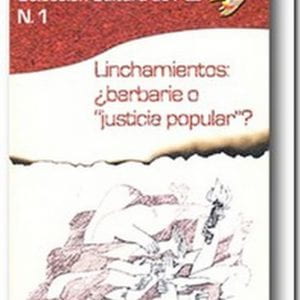A Review of Linchamientos: ¿barbarie o justicia popular?
Lynchings in Guatemala: A New Look

Linchamientos: ¿barbarie o justicia popular? Edited by Carlos Mendoza and Edelberto Torres-Rivas Colección Cultura de Paz, 2003, Guatemala.
If you have stumbled on one of those news stories telling how an angry mob turned a suspected criminal into a human torch in Guatemala and wondered how such medieval violence can take place in the 21st century, here is a book you can’t miss:Linchamientos: ¿barbarie o justicia popular? (Lynchings: barbarism or popular justice?).
This book, edited by economist Carlos Mendoza and sociologist Edelberto Torres-Rivas, is the most comprehensive analysis of a social pathology that has puzzled Guatemalans and Latin American scholars for almost a decade.
Since 1996, when the peace accords officially ended Guatemala’s 36 years of civil war between Marxist rebels and military regimes, more than 400 lynchings have occurred in this Central American country, claiming the life of at least 215 people.
The authors go beyond the two standard explanations: that Guatemalans have taken “justice” into their own hands because they do not trust the judiciary system or that lynchings are yet another legacy of the bloodiest dirty war in Latin America.
While recognizing some truth in these explanations, Mendoza and Torres-Rivas demonstrate that lynchings are a very complex phenomenon that demands more in-depth research and analysis. They have assembled a collection of eight essays that explore the social and cultural context that has fueled lynchings and look for new theoretical tools and even possible solutions.
The result is a wealth of information. Argentine political scientist Carlos Vilas shows, for example, that lynchings are not exclusive to Guatemala’s violent post-war society: they have also happened in other Latin American countries, like Mexico, Brazil, Haiti, Ecuador and Bolivia.
Vilas meticulously describes 103 lynchings in rural Mexico, in a region that is similar to the Mayan highlands. To stir clear of any assumptions he statistically dissects where lynchings occur, how they start and who takes part in them. He also studies who the victims are, how they were attacked and what happens to them and whether the police shows up.
Vilas also interprets his data. He theorizes that this kind of collective violence explodes in societies where the State is weak and lacks legitimacy. In the case of Mexico and Guatemala, the scenario is further complicated by multiculturalism and the existence of conflicting legal systems: an indigenous form of justice administration and the State’s institutions, from which most rural, Indian population feels excluded.
Another article that deserves special attention is the one written by sociologist Angelina Snodgrass Godoy. Based on her ethnographic research in the Guatemalan highlands, she shows that this new version of vigilante “justice” is modeled on the war’s atrocities, which were not only aimed to destroy entire communities, but also their social universe.
Besides comparing 1980s massacres by the Guatemalan army with modern-day lynchings, Snodgrass focuses on the often ambiguous feelings of participants and witnesses. She tells us that crowds may watch in horror someone being lynched and still feel glad that their town will be safer. The author shares poignant testimonies that bring to life the nuances, paradoxes and complexities of life in rural Guatemala. She points out, for example, that many of her informants don’t approve the use of violence in politics, but they accept it when it comes to criminals. Thus, Snodgrass states that the human rights community must reconsider the way it addresses lynchings. Looking at past human rights abuses is not enough anymore. Scholars and activists must start to “look ahead” and face how reality is challenging their theoretical and political paradigms.
She asserts that human rights activists do not know how post-war societies must tackle new forms of violence, such as lynchings. In another essay, Spanish anthropologist Julián López-García echoes Snodgrass’ preoccupation, charging that bureaucrats, politicians and activists have been extremely ineffective in their proposed ways to eradicate lynchings. Awareness campaigns and human rights workshops have failed to stop these new forms of violence.
So what are we to do? López-García says that we should not study lynchings from afar, but engage in an active dialogue with the social protagonists, “to understand first, rather than to transform.” This book is definitively an attempt to do just that.
Winter 2004, Volume III, Number 2
Dina Fernandez, a Guatemalan journalist, was a 2002-2003 Nieman Fellow at Harvard University.
Related Articles
A Review of Coffee Nation: How One Commodity Transformed the Early United States
As something of an old hand in the history of coffee enterprise, I don’t very often discover a new work that so effectively answers questions I’ve had for decades. Michelle Craig McDonald accomplishes this and much more in her multifaceted study of the coffee trade and consumption from the early 18th to late 19th centuries in what became the United States. Beyond this, however, she managed to produce an accessible, engaging text based on deep archival research, a gem for both general readers and scholars in her own field.
A Review of Serial Mexico: Storytelling across Media, from Nationhood to Now
When I was in undergrad at Emerson College, I met a student from Croatia who spoke to me in perfect Spanish. When I asked her how she was so fluent, she predictably told me she’d studied it in school. To my surprise, however, she punctuated her explanation with, “I [also] grew up watching Mexican telenovelas!” It was the turning point at which I began thinking of telenovelas as existing beyond televisions in Mexican households.
A Review of The Years of Blood: Stories of a a Reporting Life in Latin America
Her new book, The Years of Blood, offers, as its subtitle suggests, “stories from a reporting life in Latin America.” A widely decorated journalist, Guillermoprieto has written, in fact, several lives’ worth of reportage on the region. While she began chronicling Latin America in 1978, this volume collects essays published in the 21st century—most after 2010.




